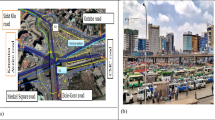Abstract
Particulate matter (PM) is the atmospheric pollutant of main concern in Makkah; therefore, there is a need for its effective monitoring, modelling and management. In this study, Atmospheric Dispersion Modelling System (ADMS)-Urban model is employed, which is a well-known atmospheric dispersion modelling system. Traffic data were collected for several years (2007–2012) on six main roads in Makkah during the months of Ramadhan and Hajj. Data analysis showed that on average, there were 83% light-duty vehicles and 17% heavy-duty vehicles on Makkah roads; however, this percentage slightly varied both spatially and temporally. The number of vehicles demonstrated increasing trend from 2007 to 2012 on the six roads. Traffic characteristics, such as vehicle speed, vehicle type and number, were used to calculate the emissions of PM10 and PM2.5. Along with pollutant emissions, ADMS-Urban requires meteorological parameters such as wind speed and direction, temperature, relative humidity, cloud cover and boundary layer height. Concentrations were predicted in three different forms: (a) for six receptors, (b) as diurnal cycles and (c) as contour maps for the whole Makkah City. Modelled concentrations were compared with the observed concentrations at Masfalah and Presidency of Meteorology and Environment (PME) monitoring stations. ADMS-Urban underestimated both PM10 and PM2.5 concentrations; however, the difference was much greater at the PME (about 73%) than at the Masfalah station (about 24%). Reasons for the discrepancies are discussed, and various statistical metrics are calculated to assess the model performance. More emission data are required to improve the performance of the model and minimise the gap between observed and predicted concentrations.








Similar content being viewed by others
References
Al-Jeelani HA (2009) Evaluation of air quality in the Holy Makkah during Hajj season 1425 H. J Appl Sci Res 5:115–121
AQEG (2012) Air Quality Expert Group, Fine particulate matter (PM2.5) in the United Kingdom. Website: https://ukair.defra.gov.uk/assets/documents/reports/cat11/1212141150_AQEG_Fine_Particulate_Matter_in_the_UK.pdf (accessed: 09.08.2017)
Barmpadimos I, Hueglin C, Keller J, Henne S, Prevot A (2011) Influence of meteorology on PM10 trends and variability in Switzerland from 1991 to 2008. Atmos Chem Phys 11:1813–1835
Caslaw D (2015) The openair manual, open-source tools for analysing air pollution data. Version: 10th June 2014, page: 230–237. Website: http://www.openair-project.org/PDF/OpenAir_Manual.pdf (accessed: 08.08.2017)
CERC (2017) Cambridge Environmental Research Consultancy Ltd. http://www.cerc.co.uk/environmental-software/ADMS-Urban-model.html (accessed: 23/07/2017)
COMEAP (2009) Long-term exposure to air pollution: effect on mortality. The Committee on the Medical Effects of Air Pollutants
Habeebullah TM (2013) Health impacts of PM10 using AirQ2.2.3model in Makkah. J Basic Appl Sci 9:259–268
Habeebullah TM, Munir S, Morsy EA, Mohammed AMF (2014) Spatial and temporal analysis of air pollution in Makkah, the Kingdom of Saudi Arabia, 5th International Conference on Environmental Science and Technology. International Proceeding of Chemical, Biological and Environmental Engineering, ISSN: 2010–4618, vol. 69: 65–70. May 14–16, 2014, Gdansk, Poland
Jones AM, Harrison RM (2006) Assessment of natural components of PM10 at UK urban and rural sites. Atmos Environ 40(2006):7733–7741
Munir S, Habeebullah TM, Seroji A, Morsy E, Mohammed A, Saud W, Abdou A, Awad A (2013a) Modeling particulate matter concentrations in Makkah, applying a statistical modeling approach. Aerosol Air Qual Res 13:901–910
Munir S, Habeebullah TM, Seroji AR, Gabr SS, Mohammed AMF, Morsy EA (2013b) Quantifying temporal trends of atmospheric pollutants in Makkah (1997–2012). Atmos Environ 77:647–655
Munir S, Habeebullah TM, Gabr S, Morsy E, Mohammed AMF, El-Saoud WA (2016) Application of ADMS-Urban in the Holy City of Makkah—modelling particulate matter (part-2). Int J Agri Environ Res 2(1):24–36
Munir S, Habeebullah TM, Gabr S, Morsy E, Mohammed AMF, El-Saoud WA (2015a) Application of ADMS-Urban in the Holy City of Makkah—modelling particulate matter (part-1). Int J Agri Environ Res 1(1):30–39
Munir S, Habeebullah TM, Mohammed AMF, Morsy EA, Awad AH, Seroji AR, Hassan IA (2015b) An analysis into the temporal variations of ground level ozone in the arid climate of Makkah applying k-means algorithms. EnvironmentAsia 8(1):53–60
Othman N, Mat-Jafri MZ, San LH (2010) Estimating particulate matter concentration over arid region using satellite remote sensing: a case study in Makkah, Saudi Arabia. Mod Appl Sci 4:11–20
Sayegh AS, Munir S, Habeebullah TM (2014) Comparing the performance of statistical models for predicting PM10 concentrations. Aerosol Air Qual Res 14:653–665
Seroji AR (2011) Particulates in the atmosphere of Makkah and Mina Valley during the Ramadan and Hajj seasons of 2004 and 2005. In: Brebbia CA, Longhurst JWS, Popov V (eds) Air pollution XIX. Wessex Institute of Technology, Ashurst
Walters S and Ayres J (2001) The health effects of air pollution. In Pollution causes, effects and control, Harrison, R.M. (Ed.), Chapter 11, pp. 275, ISBN 0-85404-621-6, fourth editions, Royal Society of Chemistry, Cambridge
Westmoreland EM, Carslaw N, Carslaw DC, Gillah A, Bates E (2007) Analysis of air quality within a street canyon using statistical and dispersion modelling techniques. Atmos Environ 41:9195–9205
WHO (2003). Health aspects of air pollution with particulate matter, ozone and nitrogen dioxide. Report on a WHO Working Group Bonn, Germany 13–15, January 2003
Acknowledgments
I greatly appreciate the institute for supporting and funding projects on environmental issues.
Funding
This study was sponsored by the Custodian of the Two Holy Mosques Institute for Hajj and Umrah Research, Umm Al-Qura University Makkah, Saudi Arabia.
Author information
Authors and Affiliations
Corresponding author
Rights and permissions
About this article
Cite this article
Munir, S., Habeebullah, T.M. Vehicular emissions on main roads in Makkah, Saudi Arabia—a dispersion modelling study. Arab J Geosci 11, 531 (2018). https://doi.org/10.1007/s12517-018-3857-z
Received:
Accepted:
Published:
DOI: https://doi.org/10.1007/s12517-018-3857-z




